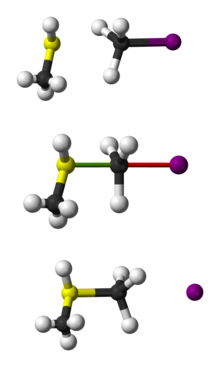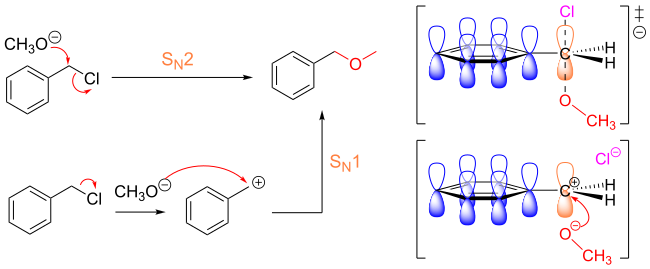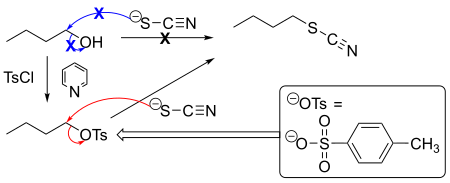SN2 reaction

Bimolecular nucleophilic substitution (SN2) is a type of reaction mechanism that is common in organic chemistry. In the SN2 reaction, a strong nucleophile forms a new bond to an sp3-hybridised carbon atom via a backside attack, all while the leaving group detaches from the reaction center in a concerted (i.e. simultaneous) fashion.
The name SN2 refers to the
The SN2 reaction can be considered as an organic-chemistry analogue of the associative substitution from the field of inorganic chemistry.
Reaction mechanism
The reaction most often occurs at an

The SN2 reaction can be viewed as a

To achieve optimal orbital overlap, the nucleophile attacks 180° relative to the leaving group, resulting in the leaving group being pushed off the opposite side and the product formed with
For example, the synthesis of macrocidin A, a fungal

If the substrate that is undergoing SN2 reaction has a

Factors affecting the rate of the reaction
The four factors that affect the rate of the reaction, in the order of decreasing importance, are:[4][5]
Substrate
The substrate plays the most important part in determining the rate of the reaction. For SN2 reaction to occur more quickly, the nucleophile must easily access the sigma antibonding orbital between the central carbon and leaving group.
SN2 occurs more quickly with substrates that are more sterically accessible at the central carbon, i.e. those that do not have as much sterically hindering substituents nearby. Methyl and primary substrates react the fastest, followed by secondary substrates. Tertiary substrates do not react via the SN2 pathway, as the greater steric hindrance between the nucleophile and nearby groups of the substrate will leave the SN1 reaction to occur first.

Substrates with adjacent pi C=C systems can favor both SN1 and SN2 reactions. In SN1, allylic and benzylic carbocations are stabilized by delocalizing the positive charge. In SN2, however, the conjugation between the reaction centre and the adjacent pi system stabilizes the transition state. Because they destabilize the positive charge in the carbocation intermediate, electron-withdrawing groups favor the SN2 reaction. Electron-donating groups favor leaving-group displacement and are more likely to react via the SN1 pathway.[1]

Nucleophile
Like the substrate, steric hindrance affects the nucleophile's strength. The
Leaving group
Good leaving groups on the substrate lead to faster SN2 reactions. A good leaving group must be able to stabilize the electron density that comes from breaking its bond with the carbon center. This leaving group ability trend corresponds well to the pKa of the leaving group's conjugate acid (pKaH); the lower its pKaH value, the faster the leaving group is displaced.
Leaving groups that are neutral, such as
Leaving group reactivity of alcohols can be increased with

The Finkelstein reaction is one SN2 reaction in which the leaving group can also act as a nucleophile. In this reaction, the substrate has a halogen atom exchanged with another halogen. As the negative charge is more-or-less stabilized on both halides, the reaction occurs at equilibrium.

Solvent
The solvent affects the rate of reaction because solvents may or may not surround a nucleophile, thus hindering or not hindering its approach to the carbon atom.
Reaction kinetics
The rate of an SN2 reaction is
- r = k[RX][Nu−]
This is a key difference between the SN1 and SN2 mechanisms. In the SN1 reaction the nucleophile attacks after the rate-limiting step is over, whereas in SN2 the nucleophile forces off the leaving group in the limiting step. In other words, the rate of SN1 reactions depend only on the concentration of the substrate while the SN2 reaction rate depends on the concentration of both the substrate and nucleophile.[1]
It has been shown[9] that except in uncommon (but predictable cases) primary and secondary substrates go exclusively by the SN2 mechanism while tertiary substrates go via the SN1 reaction. There are two factors which complicate determining the mechanism of nucleophilic substitution reactions at secondary carbons:
- Many reactions studied are solvolysis reactions where a solvent molecule (often an alcohol) is the nucleophile. While still a second order reaction mechanistically, the reaction is kinetically first order as the concentration of the nucleophile–the solvent molecule, is effectively constant during the reaction. This type of reaction is often called a pseudo first order reaction.
- In reactions where the leaving group is also a good nucleophile (bromide for instance) the leaving group can perform an SN2 reaction on a substrate molecule. If the substrate is chiral, this inverts the configuration of the substrate before solvolysis, leading to a racemized product–the product that would be expected from an SN1 mechanism. In the case of a bromide leaving group in alcoholic solvent Cowdrey et al.[10] have shown that bromide can have an SN2 rate constant 100-250 times higher than the rate constant for ethanol. Thus, after only a few percent solvolysis of an enantiospecific substrate, it becomes racemic.
The examples in textbooks of secondary substrates going by the SN1 mechanism invariably involve the use of bromide (or other good nucleophile) as the leaving group have confused the understanding of alkyl nucleophilic substitution reactions at secondary carbons for 80 years[3]. Work with the 2-adamantyl system (SN2 not possible) by Schleyer and co-workers,[11] the use of azide (an excellent nucleophile but very poor leaving group) by Weiner and Sneen,[12][13] the development of sulfonate leaving groups (non-nucleophilic good leaving groups), and the demonstration of significant experimental problems in the initial claim of an SN1 mechanism in the solvolysis of optically active 2-bromooctane by Hughes et al.[14][3] have demonstrated conclusively that secondary substrates go exclusively (except in unusual but predictable cases) by the SN2 mechanism.
E2 competition
A common
With
Roundabout mechanism
A development attracting attention in 2008 concerns a SN2 roundabout mechanism observed in a gas-phase reaction between chloride ions and
See also
- Arrow pushing
- Christopher Kelk Ingold
- Finkelstein reaction
- Neighbouring group participation
- Nucleophilic acyl substitution
- Nucleophilic aromatic substitution
- SN1 reaction
- SNi
- Substitution reaction
References
- ^ ISBN 978-0-19-927029-3.
- . Retrieved December 30, 2023.
- OCLC 1084791738.)
{{cite book}}: CS1 maint: multiple names: authors list (link - ISBN 978-0-471-72091-1
- PMID 29542853.
- PMID 29457865.
- PMID 34932346.
- PMID 32866336.
- ^ Absence of SN1 Involvement in the Solvolysis of Secondary Alkyl Compounds, T. J. Murphy, J. Chem. Educ.; 2009; 86(4) pp 519-24; (Article) doi: 10.1021/ed041p678
- .
- ^ The 2-Adamantyl System, a Standard for Limiting Solvolysis in a Secondary Substrate J. L. Fry, C. J. Lancelot, L. K. M. Lam, J. M Harris, R. C. Bingham, D. J. Raber, R. E. Hill, P. v. R. Schleyer, J. Am. Chem. Soc.,; 1970; 92, pp 1240-42 (Article); doi: 10.1021/ja00478a031
- ^ A Clarification of the Mechanism of Solvolysis of 2-Octyl Sulfonates. Stereochemical Considerations; H. Weiner, R. A. Sneen, J. Am. Chem. Soc.,; 1965; 87 pp 287-91; (Article) doi: 10.1021/ja01080a026
- ^ A Clarification of the Mechanism of Solvolysis of 2-Octyl Sulfonates. Kinetic Considerations; H. Weiner, R. A. Sneen, J. Am. Chem. Soc.; 1965; 87 pp 292-96; (Article) doi: 10.1021/ja01080a027
- ^ Homogeneous Hydrolysis and Alcoholysis of β-n-Octyl halides, E. D. Hughes, C. K. Ingold, S. Masterman, J. Chem. Soc.; 1937; pp 1196–1201; (Article) doi: 10.1039/JR9370001196
- ^ "Elimination Reactions Are Favored By Heat — Master Organic Chemistry". www.masterorganicchemistry.com. Retrieved 13 April 2018.
- ^ The technique used is electrospray ionization and because it requires charged reaction products for detection the nucleophile is fitted with an additional sulfonate anionic group, non-reactive and well separated from the other anion. The product ratio of substitution and elimination product can be measured from the intensity their relative molecular ions.
- (in Reports)
- ^ Surprise From SN2 Snapshots Ion velocity measurements unveil additional unforeseen mechanism Carmen Drahl Chemical & Engineering News January 14, 2008 Volume 86, Number 2 p. 9 http://pubsapp.acs.org/cen/news/86/i02/8602notw1.html, video included

